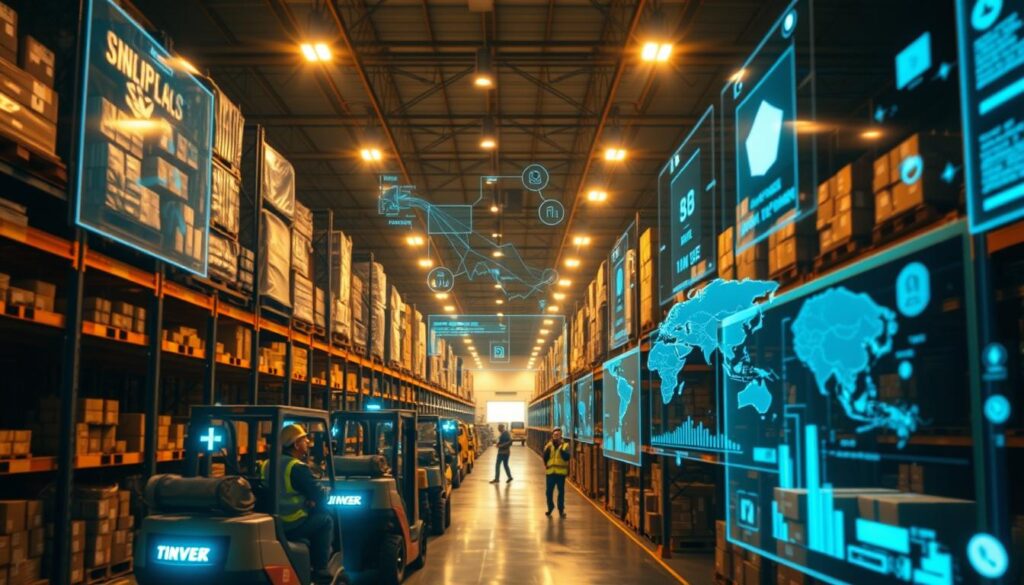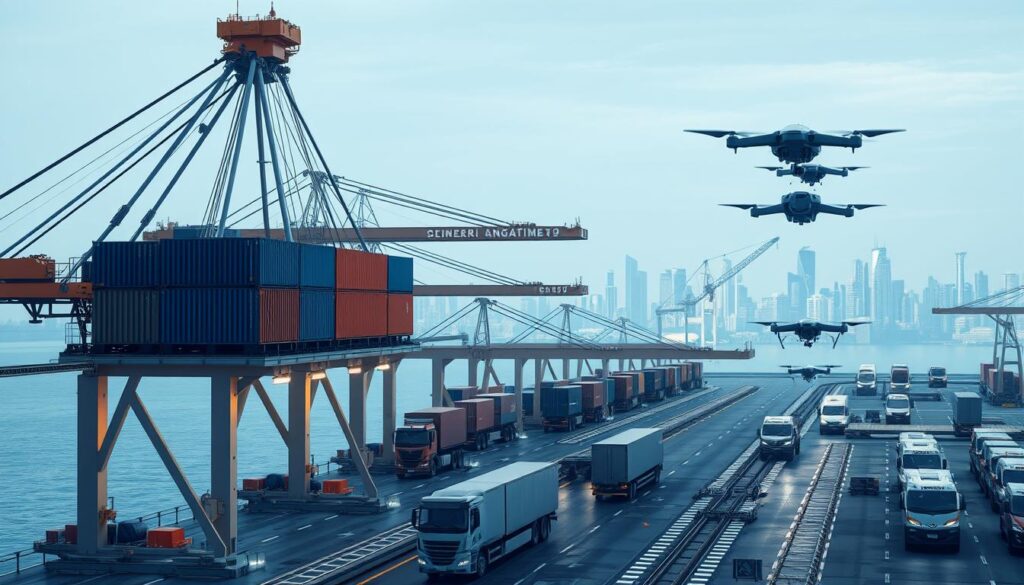Now Reading: Improve Shipping with Blockchain Logistics Shipping Tracking System
- 01
Improve Shipping with Blockchain Logistics Shipping Tracking System
Improve Shipping with Blockchain Logistics Shipping Tracking System
The COVID-19 pandemic revealed deep flaws in how goods move around the world. It disrupted the fast delivery models consumers rely on. This event forced a major rethink in how supply chains operate.
Business leaders are now investing in three key areas. They want to predict risks better, enable strong ESG monitoring, and build trust among all partners. The goal is to create a more resilient network for moving products.
For years, the global movement of goods has struggled with high costs and poor visibility. Old-fashioned methods often lead to miscommunication and expensive scaling problems. These issues cost companies billions of dollars every year.
This guide explores a powerful new approach. It shows how modern technology can bring unmatched clarity and security to the entire process. We will look at solutions that connect manufacturers, carriers, and customers seamlessly.
Key Takeaways
- The pandemic exposed critical weaknesses in traditional global supply networks.
- Current industry challenges include inefficiency, lack of visibility, and high operational costs.
- Strategic investment is now focused on predictive risk management, ESG traceability, and enhancing trust.
- Innovative technological solutions are essential for building more adaptive and resilient operations.
- This guide provides actionable insights for professionals seeking to modernize their freight and goods movement processes.
Introducing the Blockchain Logistics Shipping Tracking System
At its core, this new approach relies on a shared, unchangeable record of events visible to all authorized parties. This foundational technology creates a single source of truth for every step in the movement of goods.
Understanding Blockchain in Logistics
Imagine a digital ledger that is copied and spread across a network of computers. Each new piece of information, or “block,” is linked to the one before it. This forms a chronological chain of data that is extremely difficult to alter.
The most powerful feature is immutability. Once a transaction is recorded, it cannot be changed or deleted. This guarantees the integrity of information like shipment origins, handling details, and arrival times.
Key Components and Core Concepts
This system is built on a few essential ideas that make it so effective for complex supply chains.
- Distributed Ledger: Instead of one central database, identical copies of the ledger exist on many computers. This removes single points of failure and increases security.
- Decentralization: No single company or authority controls the data. All participants interact directly, which speeds up processes and cuts costs.
- Transparency with Control: Authorized users can see the same information simultaneously. However, permission settings ensure each party only views data relevant to their role.
By connecting manufacturers, carriers, and customers on one platform, this technology streamlines communication. It builds a new level of trust and collaboration across the entire network.
The Challenges of Traditional Shipping and Supply Chain Management
The complex dance of moving products from factory to consumer faces numerous obstacles in traditional setups. Outdated methods create friction points that slow down operations and increase expenses.
Inefficiencies, Paperwork, and Communication Gaps
Paper-based documentation remains a major hurdle for many companies. Verification procedures can take days, causing expensive delays in delivery schedules.
Multiple stakeholders maintain separate records without real-time sharing. This creates information silos where data becomes inconsistent across different parties.
| Challenge Area | Traditional Approach | Impact on Operations | Financial Cost |
|---|---|---|---|
| Document Handling | Manual paper processes | Days of verification time | High administrative costs |
| Information Sharing | Separate databases | Version control problems | Dispute resolution expenses |
| Stakeholder Coordination | Fragmented communication | Delayed issue notifications | Lost productivity hours |
| Fraud Prevention | Vulnerable paper documents | Easy document manipulation | Compliance violation fines |
Communication gaps between supply chain participants lead to delayed problem notifications. Companies cannot address issues proactively before they escalate into major disruptions.
These traditional management problems cost the industry billions annually. The urgent need for transformative solutions becomes clear when examining these operational weaknesses.
Enhancing Transparency in Shipping with Blockchain
The push for greater openness in global trade is reshaping how partners share critical shipment details. This movement addresses long-standing trust issues that hampered efficient operations.
Modern technology creates a shared environment where everyone sees the same verified information simultaneously. This eliminates confusion and builds confidence among all participants.

Decentralized Ledgers and Data Integrity
Distributed record-keeping represents a breakthrough for business relationships. Instead of one company controlling the database, identical copies exist across multiple network nodes.
This approach ensures no single entity can manipulate records without others noticing. The system creates an undeniable history of every action taken with goods.
Cryptographic linking makes historical entries practically impossible to alter. Each new piece of information connects securely to previous records, creating an unbroken chain of verified events.
All authorized participants access the same real-time updates about shipment locations and conditions. When weather delays occur, everyone receives immediate notifications to adjust plans.
This shared visibility dramatically reduces disputes between partners. Companies spend less time resolving conflicts and more time improving their operations.
The technology establishes what industry experts call a “single version of truth.” This reliable foundation enables faster problem-solving and smarter decision-making throughout the entire network.
Real-Time Tracking and Improved Data Management
Modern supply chains demand immediate insight into the whereabouts and condition of goods in transit. This need for constant visibility drives the adoption of advanced monitoring solutions.
These solutions move beyond simple location updates. They provide a comprehensive view of the entire journey.

Streamlined Operations and Efficient Processes
Continuous monitoring is achieved through IoT sensors attached to pallets and containers. These devices automatically record GPS location, temperature, and shock events.
All this information flows directly into a shared digital record. A practical case study by Deloitte demonstrates this powerful combination. They used Hyperledger Fabric, Thingstream positioning, and AWS cloud infrastructure.
The result was automated, international shipment monitoring without manual updates. This creates an undeniable history valuable for insurance and quality assurance.
| Data Aspect | Traditional Management | Modern Approach | Impact on Efficiency |
|---|---|---|---|
| Entry Method | Manual input into separate systems | Automatic sensor-to-ledger recording | Eliminates errors and redundant work |
| Update Frequency | Delayed, periodic status reports | Real-time, continuous data stream | Enables immediate problem-solving |
| Data Integrity | Prone to manipulation and disputes | Immutable, cryptographically secured record | Builds trust and reduces conflict resolution time |
| Stakeholder Access | Fragmented, siloed information | Unified, permissioned visibility for all parties | Streamlines coordination and scheduling |
This improved data handling expedites workflows. Automated notifications trigger at key milestones like port arrival.
Managers gain the ability to address issues proactively. They can reroute freight or expedite customs before delays impact customers. This leads to significantly enhanced operational performance.
Securing Transactions and Reducing Fraud in Shipping
Protecting business operations from fraudulent activities has become a critical priority in global trade networks. The industry has developed robust frameworks to address security concerns that once plagued early implementations.

Specialized firms like OpenZeppelin and CertiK now provide standardized, audited smart contract templates. These pre-vetted solutions help enterprises implement common business logic with confidence. Industry guidelines such as Ethereum Request for Comment establish proven security patterns.
Network consensus requirements create inherent fraud prevention. No single actor can alter records without others detecting the attempt. This makes falsifying documents or manipulating payment information practically impossible.
Bug bounty programs create economic incentives for security researchers. Ethical hackers identify vulnerabilities before malicious actors can exploit them. This continuous improvement cycle strengthens platforms over time.
The immutable nature of the digital ledger provides definitive proof against tampering. Any effort to alter historical transaction data breaks cryptographic links. All participating parties receive immediate alerts about suspicious activity.
This enhanced security builds trust among organizations with no prior relationships. It enables new partnerships while reducing risks from fraudulent actors. The technology creates a foundation for more secure global trade operations.
Smart Contracts and Automation in Shipping Processes
Digital agreements are revolutionizing how companies handle their freight operations. These self-executing contracts contain terms written directly into code that activates automatically.

When specific conditions are met, the agreement executes without human intervention. This creates a seamless way to manage complex processes.
Automating Workflows and Reducing Delays
Payment transactions to carriers can release instantly upon confirmed delivery. This eliminates waiting periods and accelerates cash flow throughout the supply chain.
Customs documentation and warehouse releases also benefit from this automation. The technology advances shipments automatically when requirements are satisfied.
Enhancing Compliance and Transparency
Smart contracts programmatically enforce regulatory requirements and business rules. This makes it impossible to skip essential steps in the process.
All parties can view the terms encoded on the blockchain. This creates complete transparency about whether obligations were properly fulfilled.
Freight insurance claims transform with this technology. Payments trigger automatically when damage reports or delivery confirmations appear on the distributed ledger.
This approach significantly reduces administrative costs and improves operational efficiency. Businesses save money while building stronger trust among partners.
Integration with Legacy Systems and Scalability Considerations
Adopting new digital frameworks requires careful planning for existing infrastructure. Most organizations have substantial investments in current enterprise resource planning and management platforms.
This technology functions as an add-on layer rather than a replacement solution. It interfaces with established systems through APIs and middleware connections.
Bridging Traditional and Modern Technologies
Connecting centralized databases with decentralized networks presents architectural challenges. Data must flow seamlessly between different types of platforms.
Companies can realize benefits without complete system overhauls. This approach preserves existing investments while adding new capabilities.
Scalability becomes crucial when handling high transaction volumes. Global operations may involve millions of daily status updates and documentation events.
Public networks face significant performance limitations due to their open nature. Private or consortium alternatives offer higher throughput for business applications.
Layer 1 solutions provide high-capacity platforms designed for enterprise needs. Layer 2 technologies bundle transactions to increase effective throughput.
Each approach involves trade-offs between speed, security, and decentralization. Businesses must evaluate their specific operational requirements when choosing solutions.
Future Trends and Innovations in Blockchain-Driven Shipping
The next wave of innovation in goods movement combines multiple cutting-edge technologies. These partnerships create powerful synergies that transform how businesses manage their operations.
Artificial Intelligence brings predictive capabilities to the trustworthy data recorded on distributed ledgers. This combination enables smarter decision-making across entire networks.
Emerging Technologies in Supply Chain Optimization
Internet of Things devices provide continuous real-time information about shipment conditions. Sensors automatically feed data into secure systems without manual intervention.
This creates unprecedented visibility and responsiveness. Companies can address issues before they become major problems.
Web3 applications represent the next evolution of digital platforms. Stakeholders gain greater control through peer-to-peer protocols rather than centralized intermediaries.
According to Deloitte’s research, these converged technologies create capabilities exceeding what any single solution could achieve independently. The future points toward more adaptive and resilient ecosystems.
Specific areas like freight insurance and port management will see significant transformation. Smart contracts will automate processes that currently require extensive paperwork.
As industry experts note, decentralized platforms will lower barriers for smaller businesses. They’ll access services previously available only to large corporations.
Environmental benefits will also emerge through precise carbon tracking. This helps companies meet sustainability requirements while optimizing their routes.
Conclusion
As organizations navigate the complexities of today’s interconnected markets, innovative technological approaches are redefining operational excellence. The integration of blockchain solutions offers transformative potential for managing the movement of goods across global networks.
Early adopters gain significant competitive advantages through enhanced transparency and automated processes. While implementation requires careful planning, the benefits in security and efficiency position businesses for long-term success.
Specialized providers like QSS Technosoft deliver tailored solutions that ensure seamless integration with existing operations. Their expertise helps companies unlock the full potential of digital transformation in the supply chain industry.
The future promises even greater advancements as this technology converges with AI and IoT. Organizations that embrace these changes today will lead the evolution of commercial transportation services.
FAQ
How does a decentralized ledger improve supply chain transparency?
A decentralized ledger provides a single, unchangeable record of all transactions. Every participant in the supply chain can view the same data, which builds trust. This shared visibility reduces disputes and ensures everyone has access to accurate information about goods, from origin to final delivery.
What are smart contracts and how do they benefit supply chain operations?
Smart contracts are self-executing agreements with terms written directly into code. They automate payments and other actions when pre-set conditions are met, like confirming a delivery. This automation speeds up processes, cuts administrative costs, and minimizes human error, leading to greater efficiency.
Can this technology integrate with our company’s existing management systems?
A> Yes, integration with current enterprise resource planning (ERP) and warehouse management systems is a key focus. Solutions are designed to work alongside legacy technologies, allowing businesses to enhance data management and visibility without a complete and costly system overhaul.
How does this approach enhance security and reduce fraud?
The technology creates a permanent and tamper-proof record of every event. Any attempt to alter data is immediately visible to all authorized parties. This high level of security makes it extremely difficult for fraudulent activities, such as falsifying shipment status or documents, to go undetected.
What kind of real-time visibility can we expect for our shipments?
You gain instant access to a shipment’s location, condition, and estimated time of arrival. Sensors and IoT devices feed data directly into the immutable ledger. This allows for proactive management of the entire journey, helping to prevent delays and improve customer service with accurate updates.
Are there significant cost savings associated with adopting this system?
Absolutely. Primary savings come from reducing paperwork, automating manual processes, and minimizing delays. By cutting out intermediaries and streamlining operations, companies often see a decrease in operational costs and an improvement in overall financial performance.












